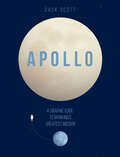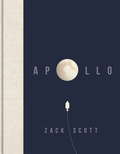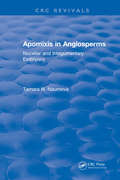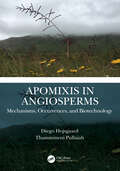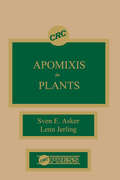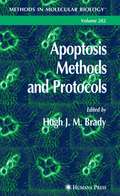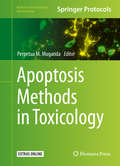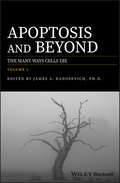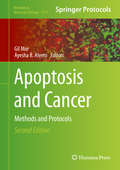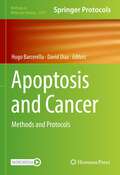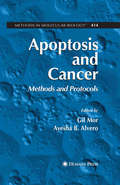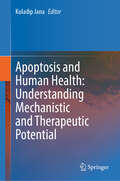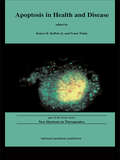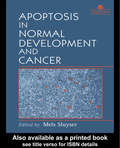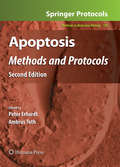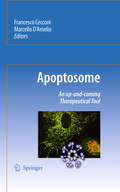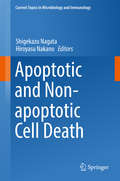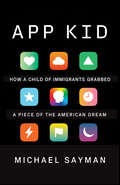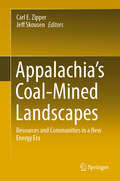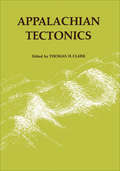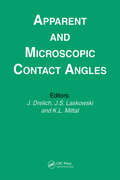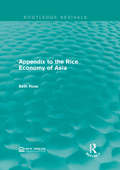- Table View
- List View
Apollo: A Graphic Guide to Mankind's Greatest Mission
by Zack ScottIllustrations, infographics, and little-known facts about NASA’s Apollo program and the 1969 moon landing.July 20, 1969, marked one of the greatest achievements of mankind—the moon landing. In his infographic-packed book, Apollo: A Graphic Guide to Mankind’s Greatest Mission, Zack Scott recounts the entire journey of the Apollo space program. Unlike previous books on this topic, Apollo illustrates the tiniest details of how man came to walk on the moon, paying particular attention to many of the lesser-known facts about the mission. Artful infographics throughout focus on a wide range of details for space-lovers to obsess over—astronaut weights, mission insignia and spacecraft call signs, fuel consumption stats, splashdown sites around the world, and much, much more. A fresh, lively approach to the subject, Apollo is the perfect combination of science, design, math, and space.
Apollo: The extraordinary visual history of the iconic space programme
by Zack ScottExplore the iconic Apollo space missions and moon landings through these stunning infographics and data visualisations. If you like space, this book is for you.The Apollo Program ran from 1961 until 1972, and marks one of the greatest accomplishments in all of human endeavour - man walking on the moon. On 20th July 1969, Neil Armstrong and Buzz Aldrin achieved this most remarkable feat, becoming the first humans to visit another celestial body.Apollo is an extraordinary visual history of the story of this iconic space programme, based on recently released NASA data about the various missions of that name. Using beautifully designed infographics, Apollo takes us through all the astonishing facts and figures, as well as some quirky little-known details, and gives us a detailed and elegant history of the seventeen missions which saw twelve humans step on the surface of the moon. Apollo gives us an insight in to the incredible individuals who made that journey.What readers are saying about Apollo:'Always loved NASA and the Apollo missions and this book breaks down all the rockets and missions so you can understand every detail''Love it, would highly recommend. Easy for everyone to understand and a great gift''Five stars'
Apomixis in Angiosperms
by Tamara N. NaumovaApomixis in Angiosperms: Nucellar and Integumentary Embryony is based on original cytoembryological data and critically reviewed literature on more than 250 species from 57 families of angiosperms. The book covers the complete process of nucellar and integumentary embryo formation and viable seed development within species, families, and among angiosperms in general. Many species (some of which are economically important) characterized by adventive embryony are listed. The book also provides an original simple classification of apomixis and offers a new approach to differentiating embryological structures in cases of apomixis and amphimixis.Apomixis in Angiosperms: Nucellar and Integumentary Embryony will be a useful reference for embryologists, botanists, cytologists, geneticists, and plant breeders. It will also benefit any researcher interested in studying somatic embryo formation in tissue culture.
Apomixis in Angiosperms: Mechanisms, Occurrences, and Biotechnology
by Thammineni Pullaiah Diego HojsgaardApomixis is a difficult-to-analyse trait with a complex molecular basis and a substantive effect on the biology of a species. Thus, apomixis is an interesting characteristic for researchers and students working in different fields of plant science and agriculture, and technological advances are enabling and making apomixis studies more common. Apomixis in Angiosperms: Mechanisms, Occurrences, and Biotechnology provides a systematic introduction to the mechanisms and developmental types of apomixis along with an overview of alternative methodologies for identifying apomixis and a detailed reassessment of the occurrences of apomictic species among angiosperm families. Optional methods are illustrated with examples of all types of apomixis and biological levels of analysis, i.e. cells, ovules, seeds and offspring. Data on apomictic species are collected in tables along with information on ploidy, type of apomixis and references. Occurrences of apomixis are briefly discussed in phylogenetic and evolutionary contexts. An outline of the molecular basis of apomixis in plants is presented, together with prospects and challenges that remain for its biotechnological exploitation. This book: Provides a systematic overview of the mechanisms of apomixis, developmental types and methodology for apomixis research. Reassesses apomixis at the species level in angiosperm families. Contains tables summarizing relevant information on apomixis. Analyses occurrences of apomixis in phylogenetic and evolutionary contexts. Outlines the molecular basis and biotechnological perspective of apomixis breeding. This book presents an accessible overview of apomixis research and a curated dataset of apomictic species. It serves as a reference book for students, researchers and citizen scientists interested in apomixis, as well as researchers, business innovators and entrepreneurs pursuing apomixis breeding. It can also be used as a textbook in graduate courses on plant reproduction. Diego Hojsgaard Taxonomy and Evolutionary Biology, Leibniz Institute of Plant Genetics and Crop Plant Research, Gatersleben, Germany, and Faculty of Exact, Chemical and Natural Sciences, National University of Misiones, Posadas, Argentina. Thammineni Pullaiah Department of Botany, Sri Krishnadevaraya University, Anantapur, India.
Apomixis in Plants
by Lenn JerlingApomixis in Plants presents a comprehensive review of different aspects of asexual seed formation in plants. This is important in plant research since apomixis could greatly facilitate breeding in important crops. It is also interesting theoretically because it carries problems related to genetic variation and evolution to its extreme.The book features a broad selection of topics, including a historical review of ideas and landmarks in the field; comparisons with other types of asexual reproduction in higher plants and with related phenomena in animals and related plants; a presentation of cytology and embryology of apomicts and the diversified terminology in the field; views on the genetic background of apomixis and environmental effects on its expression; and the interrelation between apomixis and other traits. Additional topics covered include classical and modern theories of sexual versus asexual reproduction; geographical and taxonomical trends in apomicts; ecological implications of apomixis, and a review of future possibilities for using apomixis in plant breeding. Apomixis in Plants is an important reference volume for researchers and students in all areas of botany, ecology, and plant breeding.
Apoptosis
by Douglas R. Green John C. ReedApoptosis, or cell death, can be pathological, a sign of disease and damage, or physiological, a process essential for normal health. This book, with contributions from experts in the field, provides a timely compilation of reviews of mechanisms of apoptosis. The book is organized into three convenient sections. The first section explores the different processes of cell death and how they relate to one another. The second section focuses on organ-specific apoptosis-related diseases. The third section explores cell death in non-mammalian organisms, such as plants. This comprehensive text is a must-read for all researchers and scholars interested in apoptosis.
Apoptosis Methods and Protocols (Methods in Molecular Biology #282)
by Hugh J. BradyA collection of cutting-edge techniques for detecting and quantifying apoptosis, understanding its biochemistry, and for identifying the genes and proteins that regulate and carry it out. Described in step-by-step detail, these readily reproducible methods range from flow cytometry and immunohistochemical procedures to kinase activity assays, yeast two-hybrid screening, and the cloning of novel genes by differential expression. The protocols follow the successful Methods in Molecular BiologyTM series format, each one offering step-by-step laboratory instructions, an introduction outlining the principle behind the technique, lists of equipment and reagents, and tips on troubleshooting and avoiding known pitfalls. Apoptosis Methods and Protocols constitutes a key technical reference to the significant methodologies used in the field, as well as offering novice and experienced researchers alike powerful tools to illuminate the phenomenon of programmed cell death.
Apoptosis Methods in Toxicology (Methods in Pharmacology and Toxicology)
by Perpetua M. MugandaThis detailed volume provides a single, valuable reference source formethods that definitively identify and accurately quantify apoptosis. The bookbegins with common methods utilized to detect and quantitate apoptosis, as wellas apoptosis signaling pathways in toxicological and other related research. Itcontinues with multi-parametric and phased apoptosis assays for detecting earlyand late apoptosis or distinguishing apoptosis from necrosis and autophagy. Subsequent chapters focus on recent advances in real time and high-throughputassays that detect and quantitate apoptosis and apoptosis signaling pathways. Final chapters focus on recent developments in preclinical anticancertherapeutics targeting apoptosis. Written for the Methods in Pharmacologyand Toxicology series, chapters feature step-by-step descriptions of themethodologies, as well as expert tips and implementation advice. Vital and authoritative, Apoptosis Methods inToxicology serves novice scientists as well as experts,utilizing a range of instruments from common laboratory equipment to high-endexpensive and automated machinery capable of performing real time apoptoticmeasurements.
Apoptosis and Beyond: The Many Ways Cells Die
by James A. RadosevichThese volumes teach readers to think beyond apoptosis and describes all of the known processes that cells can undergo which result in cell death This two-volume source on how cells dies is the first, comprehensive collection to cover all of the known processes that cells undergo when they die. It is also the only one of its kind to compare these processes. It seeks to enlighten those in the field about these many processes and to stimulate their thinking at looking at these pathways when their research system does not show signs of activation of the classic apoptotic pathway. In addition, it links activities like the molecular biology of one process (eg. Necrosis) to another process (eg. apoptosis) and contrasts those that are close to each. Volume 1 of Apoptosis and Beyond: The Many Ways Cells Die begins with a general view of the cytoplasmic and nuclear features of apoptosis. It then goes on to offer chapters on targeting the cell death mechanism; microbial programmed cell death; autophagy; cell injury, adaptation, and necrosis; necroptosis; ferroptosis; anoikis; pyronecrosis; and more. Volume 2 covers such subjects as phenoptosis; pyroptosis; hematopoiesis and eryptosis; cyclophilin d-dependent necrosis; and the role of phospholipase in cell death. Covers all known processes that dying cells undergo Provides extensive coverage of a topic not fully covered before Offers chapters written by top researchers in the field Provides activities that link and contrast processes to each other Apoptosis and Beyond: The Many Ways Cells Die will appeal to students and researchers/clinicians in cell biology, molecular biology, oncology, and tumor biology.
Apoptosis and Cancer: Methods and Protocols (Methods in Molecular Biology #1219)
by Gil Mor Ayesha B. AlveroIn Apoptosis and Cancer: Methods and Protocols, Second Edition, expert researches in the field detail the performance of molecular and cellular biology techniques for studying and detecting the activation of the apoptotic pathway. Chapters focus on assays developed to detect its activation not only in vitro but also in vivo, optimized multiplex analysis, medium- to high-throughput screens, and the cellular process. Written in the highly successful Methods in Molecular Biology series format, chapters include introductions to their respective topics, lists of the necessary materials and reagents, step-by-step, readily reproducible laboratory protocols, and key tips on troubleshooting and avoiding known pitfalls. Authoritative and practical, Apoptosis and Cancer: Methods and Protocols, Second Edition aids scientists as a stand-alone resource for the execution and analysis of the described protocols and as a reference for the study and detection of apoptosis within and outside the area of cancer research.
Apoptosis and Cancer: Methods and Protocols (Methods in Molecular Biology #2543)
by David Diaz Hugo BarcenillaThis volume discusses methods used in the fields of molecular and cellular biology for detecting and studying cell death, especially in cancer and cancer therapy. Chapters in this book cover topics such as non-destructive, real-time Annexin V apoptosis assay; assessment of the immune response to tumor cell apoptosis and efferocytosis; mass cytometry assessment of cell phenotypes and signaling states in human whole blood; cell cycle analysis of ER stress and autophagy; and simultaneous detection of inflammasome activation and membrane damage during pyroptosis. Written in the highly successful Methods in Molecular Biology series format, chapters include introductions to their respective topics, lists of the necessary materials and reagents, step-by-step, readily reproducible laboratory protocols, and tips on troubleshooting and avoiding known pitfalls.Cutting-edge and practical, Apoptosis and Cancer: Methods and Protocols is a valuable resource and practical guide for both novice and expert researchers looking into the “meaning of death.”
Apoptosis and Cancer: Methods and Protocols (Methods in Molecular Biology #414)
by Ayesha Alvero Gil MorThe aim of Apoptosis and Cancer is to describe the performance of contemporary techniques for studying the biology of apoptosis and its role in cancer. The protocols described will aid both the academic laboratory interested in further characterizing the mechanisms of apoptosis, as well as the industry laboratory, aimed at identifying new target molecules or screening for new compounds with potential clinical use.
Apoptosis and Human Health: Understanding Mechanistic and Therapeutic Potential
by Kuladip JanaThis book comprehensively reviews the recent advancements in apoptosis research and evaluates its therapeutic targets and strategies in controlling various human diseases. The initial chapter presents the molecular components that regulate apoptosis and its importance for pathogenic processes. The subsequent chapters discuss the molecular mechanisms and signaling pathways involved in apoptosis induction and inhibition. The book also examines the role of mitochondria-driven apoptosis and therapeutic strategies for targeting mitochondria-mediated cell death. Further, the book discusses the role of apoptosis in different diseases, including neurodegeneration, cancer, diabetes, cardiovascular diseases, parasitic infections, autoimmune diseases, reproductive disorders, and infertility. Towards the end, the book outlines the recent advances in the field of apoptosis-based therapies and explores some highlights of a very active field of drug development. This book is useful for the researchers involved in designing and developing new drugs and drug targets for the treatment of different human diseases.
Apoptosis in Health and Disease (New Horizons In Therapeutics Ser. #Vol. 3)
by Jr. Robert R. Ruffolo Frank WalshThe impact of Apoptosis, or programmed cell death, is thought to play a crucial role in the development and progression of disease. Whilst Apoptosis remains extensively studied in the context of immunology, the focus of research has greatly expanded to investigate the key role it is now believed to play in hematopoiesis, angiogenesis, inflammation
Apoptosis in Normal Development and Cancer
by Mels SluyserIn apoptosis in the mammalian system, cells have a finite life - they develop, are used and then die. Cancer cells escape this programmed routine but, from an understanding of apoptosis, they can be programmed to die. This book addresses the
Apoptosis: Methods and Protocols, Second Edition (Methods in Molecular Biology #559)
by P. Erhard Ambrus TothThe ability to detect and quantify apoptosis, to understand its biochemistry, and to identify its regulatory genes and proteins is crucial to biomedical research. In Apoptosis: Methods and Protocols, Second Edition, expert researchers describe the techniques to best investigate the critical steps involved in the apoptotic process. Presented from several different research perspectives, the volume contains sections covering detection of apoptosis, detection of non-apoptotic cell death, modifications of apoptotic proteins during apoptosis, the analysis of its major regulators, as well as analysis of apoptosis in different organs and in model organisms. Written in the highly successful Methods in Molecular BiologyTM series format, chapters include introductions to their respective topics, lists of the necessary materials and reagents, step-by-step, readily reproducible protocols, and notes on troubleshooting and avoiding known pitfalls. Comprehensive and cutting-edge, Apoptosis: Methods and Protocols, Second Edition constitutes a key technical reference to the significant methodologies used in the field, and offers beginners and experienced researchers powerful tools to illuminate the phenomena of programmed cell death.
Apoptosome: An up-and-coming therapeutical tool
by Marcello D'Amelio Francesco Cecconi"Apoptosome" is the first book that presents a concise synthesis of recent developments in the understanding of how the activation of the cell death cascade is handled by a cytosolic signalling platform known as the apoptosome. The book also discusses how insights into the regulation of apoptosome may be exploited for designing new drugs aimed at interfere with a plethora of pathogenetic processes involved in human diseases. The authors emphasize novel translational approaches that are rapidly moving from the laboratory bench top to the patient's bedside for the future treatment of diseases associated with apoptosis. This book will be a valuable resource for researchers investigating the role of apoptosome-dependent cell death in cancer and other diseases, for researchers investigating the molecular mechanism of chemotherapeutic agents and drug-resistance and for physicians using chemotherapeutic agents. Additionally, this book will be an important educational source for PhD students and MD students specializing in molecular and cell biology, and to anybody interested in science, medicine, as well as in recent developments of the ideas and concepts of the molecular biology of programmed cell death.
Apoptotic and Non-apoptotic Cell Death (Current Topics in Microbiology and Immunology #403)
by Shigekazu Nagata Hiroyasu NakanoApoptosis is a prototype of regulated cell death and is executed by the sequential activation of caspases, and plays a crucial role in the process for development and tissue homeostasis of multicellular organisms. In the process of apoptosis, dead cells produce a "find me" signal to recruit phagocytes, and present an "eat me" signal. The prompt clearance of dead cells by phagocytes prevents the release of noxious materials from dying cells that may activate the immune system to develop autoimmune diseases. In addition, apoptotic cells release various factors that are involved in inflammation, proliferation, immune tolerance, and tissue repair in a context dependent manner. In addition to apoptosis, current studies revealed various types of non-apoptotic forms of cell death including regulated necrosis, pyroptosis, entosis, and ferroptosis etc. Among them, the regulated necrosis, also called necroptosis, plays a crucial role in ischemic reperfusion injury, drug-induced pancreatitis, and elimination of virus infection. Whereas, pyroptosis is the cell death induced by bacteria or viral infection, and entosis is the killing through the cell-in cell structure. The molecular mechanisms of these cell death processes are currently extensively studied. In this text book, current advances of cell death research and its future direction will be introduced and discussed.
App Kid (Spanish-language Edition)
by Michael SaymanUna historia inspiradora y profundamente personal de uno de los empresarios más extraordinarios de Silicon Valley, quien aprendió a codificar por sí mismo cuando tenía trece años y así comenzó su sueño americano. Cuando veía que sus padres perdían sus trabajos a raíz de la Gran Recesión, Michael Sayman, entonces de trece años, hacía una búsqueda en Google: "¿Cómo codificar?". En un año ya había lanzado una aplicación para el iPhone y con ella ganaba miles de dólares al mes, lo suficiente para mantener a su familia a flote y sin tener que irse de Estados Unidos. Totalmente autodidacta, Sayman pasó de la escuela secundaria directamente al mundo profesional, y cuando tenía diecisiete años, era el empleado más joven de Facebook, creando nuevas funciones que cautivaron a Mark Zuckerberg. Tres años después, decidió irse a Google. En estas memorias sinceras e inspiradoras, Sayman comparte los altibajos, los éxitos y fracasos, de su trascendental viaje. Cuenta la apasionante historia de cómo un joven latino, que aún ni tenía la mayoría de edad, se destacó y triunfó en el despiadado y feroz mundo de Silicon Valley. Además, está lleno de sabiduría práctica, por lo que es una lectura necesaria e inspiradora para aquellas personas que marchan a su propio ritmo.
App Kid: How a Child of Immigrants Grabbed a Piece of the American Dream
by Michael SaymanAn inspiring and deeply personal coming of age memoir from one of Silicon Valley&’s youngest entrepreneurs—a second-generation Latino immigrant who taught himself how to code as a thirteen-year-old and went on to claim his share of the American dream.As his parents watched their restaurant business collapse in the wake of the Great Recession, Michael Sayman was googling &“how to code.&” Within a year, he had launched an iPhone app that was raking in thousands of dollars a month, enough to keep his family afloat—and in America. Entirely self-taught, Sayman headed from high school straight into the professional world, and by the time he was seventeen, he was Facebook&’s youngest employe ever, building new features that wowed its founder Mark Zuckerberg and are now being used by more than half a billion people every day. Sayman pushed Facebook to build its own version of Snapchat&’s Stories and, as a result, engagement on the platform soared across all demographics. Millions of Gen Z and Millennials flocked to Facebook, and as teen engagement rose dramatically on Instagram and WhatsApp, Snapchat&’s parent company suffered a billion-dollar loss in value. Three years later, Sayman jumped ship for Google.App Kid is the galvanizing story of a young Latino, not yet old enough to drink, who excelled in the cutthroat world of Silicon Valley and went on to become an inspiration to thousands of kids everywhere by following his own surprising, extraordinary path. In this candid and uplifting memoir, Sayman shares the highs and lows, the successes and failures, of his remarkable journey. His book is essential and affirming reading for anyone marching to the beat of their own drum.
Appalachia's Coal-Mined Landscapes: Resources and Communities in a New Energy Era
by Carl E. Zipper Jeff SkousenThis book collects and summarizes current scientific knowledge concerning coal-mined landscapes of the Appalachian region in eastern United States. Containing contributions from authors across disciplines, the book addresses topics relevant to the region’s coal-mining history and its future; its human communities; and the soils, waters, plants, wildlife, and human-use potentials of Appalachia’s coal-mined landscapes.The book provides a comprehensive overview of coal mining’s legacy in Appalachia, USA. It book describes the resources of the Appalachian coalfield, its lands and waters, and its human communities – as they have been left in the aftermath of intensive mining, drawing upon peer-reviewed science and other regional data to provide clear and objective descriptions. By understanding the Appalachian experience, officials and planners in other resource extraction- affected world regions can gain knowledge and perspectives that will aid their own efforts to plan and manage for environmental quality and for human welfare.Appalachia's Coal-Mined Landscapes: Resources and Communities in a New Energy Era will be of use to natural resource managers and scientists within Appalachia and in other world regions experiencing widespread mining, researchers with interest in the region’s disturbance legacy, and economic and community planners concerned with Appalachia’s future.
Appalachian Tectonics (The Royal Society of Canada #No. 10)
by Thomas H. ClarkMountain ranges are the most conspicuous elements of the earth's architecture, and the manner in which the architectural units are arranged or disarranged has become the study of a subdivision of geology known as Tectonics. A hundred years ago James Hall attempted the first scientific synthesis of the steps in the building of the eastern North American mountains, the Appalachians. His initial hypothesis of 1857, expanded and broadened by J.D. Dana during the decade which followed, laid the foundation for our modern geosynclinal theory of mountain building. During the last century of modifications and refinements were contributed concerning the roles played by crustal compression, sub-crustal convection currents, batholiths, metamorphism, gravity sliding, and isostasy. In recent years detailed mapping, supplemented by studies of turbidity currents, paleomagentism, stable isotopes, and radio-activity have helped to unravel the history of mountain building, but today there are as many questions unanswered as there are those for which there are tentative solutions.<P><P>Aspects of Appalachian orogeny was a suitable subject for the symposium of the Royal Society of Canada Annual Meeting in 1966 at Sherbrooke, Quebec—a city within the Appalachian Mountain System. This book assembles the papers of this symposium, dealing with gravity sliding, studies of sedimentation and structure in limited areas, comparisons with the Appalachians of the United States, the bearing of gravity measurements upon our understanding of mountain structure, earthquakes, and a broad, general view of the tectonic pattern of the earth of which this mountain-built belt is but a small part.<P>Such a comprehensive volume, bringing together a variety of points of view of some of the foremost scholars in the field, indicates the vastness of the subject, the significant progress made thus far, the necessity for new and progressive methods of exploration, and above all the interdependence of all the workers in the field, no matter how seemingly unrelated their specialties are.
Apparent and Microscopic Contact Angles
by K. L. Mittal J. S. Laskowski J. DreHchThis book chronicles the proceedings of the International Symposium on Apparent and Microscopic Contact Angles, held in conjunction with the American Chemical Society meeting in Boston, August 24--27, 1998. The symposium provided an opportunity to discuss several controversial issues associated with interfacial phenomena that govern the behavior of
Appendix to the Rice Economy of Asia (Routledge Revivals)
by Beth RoseOriginally published in 1985, Beth Rose’s Appendix to the Rice Economy of Asia provides twenty-six tables detailing various rice statistics across Asia from the beginning of the twentieth century through to the 1980’s. Statistics presented include; total crop area, rice production and yield, import and export, rice prices, farm wages and populations of countries or areas within Asia. This title will be of interest to students of Environmental Studies and Economics.
Appetite and Its Discontents: Science, Medicine, and the Urge to Eat, 1750-1950
by Elizabeth A. WilliamsWhy do we eat? Is it instinct? Despite the necessity of food, anxieties about what and how to eat are widespread and persistent. In Appetite and Its Discontents, Elizabeth A. Williams explores contemporary worries about eating through the lens of science and medicine to show us how appetite—once a matter of personal inclination—became an object of science. Williams charts the history of inquiry into appetite between 1750 and 1950, as scientific and medical concepts of appetite shifted alongside developments in physiology, natural history, psychology, and ethology. She shows how, in the eighteenth century, trust in appetite was undermined when researchers who investigated ingestion and digestion began claiming that science alone could say which ways of eating were healthy and which were not. She goes on to trace nineteenth- and twentieth-century conflicts over the nature of appetite between mechanists and vitalists, experimentalists and bedside physicians, and localists and holists, illuminating struggles that have never been resolved. By exploring the core disciplines in investigations in appetite and eating, Williams reframes the way we think about food, nutrition, and the nature of health itself..
